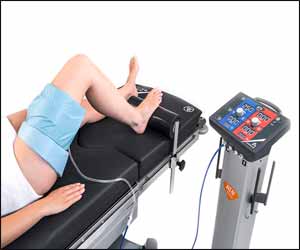- Home
- Editorial
- News
- Practice Guidelines
- Anesthesiology Guidelines
- Cancer Guidelines
- Cardiac Sciences Guidelines
- Critical Care Guidelines
- Dentistry Guidelines
- Dermatology Guidelines
- Diabetes and Endo Guidelines
- Diagnostics Guidelines
- ENT Guidelines
- Featured Practice Guidelines
- Gastroenterology Guidelines
- Geriatrics Guidelines
- Medicine Guidelines
- Nephrology Guidelines
- Neurosciences Guidelines
- Obs and Gynae Guidelines
- Ophthalmology Guidelines
- Orthopaedics Guidelines
- Paediatrics Guidelines
- Psychiatry Guidelines
- Pulmonology Guidelines
- Radiology Guidelines
- Surgery Guidelines
- Urology Guidelines
Widely used tourniquets contaminated with deadly bacteria

A device used for drawing blood could be a source for many diseases, according to a recent study. The researchers identified widely used tourniquets to be contaminated with deadly bacteria.
The study, presented at the 2019 annual European Congress of Clinical Microbiology and Infectious Diseases, found that little rubber tourniquets appear to be contaminated with a variety of disease-producing organisms and could put patients at risk.
In healthcare, tourniquets are one of the most widely used and reused items in health care. They are used during venipuncture -- a process of obtaining intravenous access for the purpose of intravenous therapy or for blood sampling of venous blood. venipuncture is the most frequently performed invasive procedure in health care settings.
Nádia Osório, a professor in the Department of Pharmacy at the Polytechnic Institute of Coimbra, in Coimbra, Portugal, and colleagues reviewed the literature to determine bacterial contamination rates found in reusable tourniquets across a range of clinical studies. They also wanted to identify the most prevalent contaminant microorganisms.
Traditionally these items are reused between patients, which could pose a risk for cross-contamination, according to Dr Osório.
For the study, the researchers considered both unpublished and published studies written up to December 2017. They selected 20 clinical studies with a combined total sample size of 1,479 tourniquets.
Key findings of the study include:
- Contamination rates varied from 10% to 100%, with coagulase-negative staphylococci found most often—present on 441 of the tourniquets analyzed.
- Coagulase-negative staphylococci can cause a range of infections, including skin and soft tissue infections.
- They also found contamination by other species of bacteria including Escherichia coli, Enterococcus, Klebsiella, Pseudomonas, Acinetobacter baumannii and Stenotrophomonas maltophilia.
- They found individual contamination rates of up to 10% for each species.
- These organisms cause a range of potentially serious illnesses, such as pneumonia, and represent a particular risk to immunocompromised patients or those with chronic illnesses, such as cystic fibrosis.
- In 15 of the studies, contamination rates were higher than 70% of the tourniquets analyzed.
"These results highlighted failures in the decontamination and asepsis of these medical devices that are frequently used in invasive procedures, specifically to take blood or for peripheral IV catheterization," said Dr Osório.
Another concern was that “the majority of the Staphylococcus found in the major articles also present methicillin resistance. Methicillin-resistant Staphylococcus aureus is one of the several species involved in healthcare-associated infections,” she said.
Resistance also was found among the other species identified. “Transmission of microorganisms between patients in the hospital environment can be a potential cause of secondary infections, increasing the time of treatments, with more costs and more time in the hospital,” Dr Osório explained.
“The purpose of our work is only to map the scientific evidence relative to the microbiological contamination in the tourniquets, rate, species and antibiotic resistance in the species found,” she said. “However, if we used these medical devices in invasive procedures, the risks of contamination increase, and maybe for this we have some cases of phlebitis, bacteremia and sepsis related to catheter insertions, for example.”
More research should be conducted to find the best method for decontaminating tourniquets that are reused or to see whether single-use, disposable tourniquets should be used in clinical settings.
Dr. Osório called the tourniquets very useful medical devices that are fundamental to the provision of health care, so the costs involved in ensuring aseptic procedures or in switching to disposable devices would be lower than dealing with a hospital-acquired skin or bloodstream infection that would increase the length of stay.

Disclaimer: This site is primarily intended for healthcare professionals. Any content/information on this website does not replace the advice of medical and/or health professionals and should not be construed as medical/diagnostic advice/endorsement or prescription. Use of this site is subject to our terms of use, privacy policy, advertisement policy. © 2020 Minerva Medical Treatment Pvt Ltd